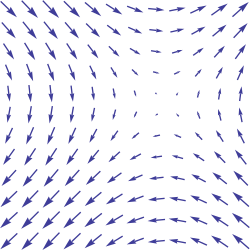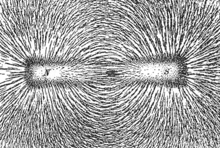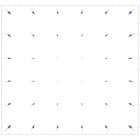Vector field

Invector calculusandphysics,avector fieldis an assignment of avectorto each point in aspace,most commonlyEuclidean space.[1]A vector field on aplanecan be visualized as a collection of arrows with given magnitudes and directions, each attached to a point on the plane. Vector fields are often used to model, for example, the speed and direction of a moving fluid throughoutthree dimensional space,such as thewind,or the strength and direction of someforce,such as themagneticorgravitationalforce, as it changes from one point to another point.
The elements ofdifferential and integral calculusextend naturally to vector fields. When a vector field representsforce,theline integralof a vector field represents theworkdone by a force moving along a path, and under this interpretationconservation of energyis exhibited as a special case of thefundamental theorem of calculus.Vector fields can usefully be thought of as representing the velocity of a moving flow in space, and this physical intuition leads to notions such as thedivergence(which represents the rate of change ofvolumeof a flow) andcurl(which represents the rotation of a flow).
A vector field is a special case of avector-valued function,whose domain's dimension has no relation to the dimension of its range; for example, theposition vectorof aspace curveis defined only for smaller subset of the ambient space. Likewise, ncoordinates,a vector field on a domain inn-dimensional Euclidean spacecan be represented as a vector-valued function that associates ann-tuple of real numbers to each point of the domain. This representation of a vector field depends on the coordinate system, and there is a well-defined transformation law (covariance and contravariance of vectors) in passing from one coordinate system to the other.
Vector fields are often discussed onopen subsetsof Euclidean space, but also make sense on other subsets such assurfaces,where they associate an arrow tangent to the surface at each point (atangent vector). More generally, vector fields are defined ondifferentiable manifolds,which are spaces that look like Euclidean space on small scales, but may have more complicated structure on larger scales. In this setting, a vector field gives a tangent vector at each point of the manifold (that is, asectionof thetangent bundleto the manifold). Vector fields are one kind oftensor field.
Definition
[edit]Vector fields on subsets of Euclidean space
[edit]Given a subsetSofRn,avector fieldis represented by avector-valued functionV:S→Rnin standardCartesian coordinates(x1,…,xn).If each component ofVis continuous, thenVis a continuous vector field. It is common to focus onsmoothvector fields, meaning that each component is asmooth function(differentiable any number of times). A vector field can be visualized as assigning a vector to individual points within ann-dimensional space.[1]
One standard notation is to writefor the unit vectors in the coordinate directions. In these terms, every smooth vector fieldon an open subsetofcan be written as
for some smooth functionson.[2]The reason for this notation is that a vector field determines alinear mapfrom the space of smooth functions to itself,,given by differentiating in the direction of the vector field.
Example:The vector fielddescribes a counterclockwise rotation around the origin in.To show that the functionis rotationally invariant, compute:
Given vector fieldsV,Wdefined onSand a smooth functionfdefined onS,the operations of scalar multiplication and vector addition, make the smooth vector fields into amoduleover theringof smooth functions, where multiplication of functions is defined pointwise.
Coordinate transformation law
[edit]In physics, avectoris additionally distinguished by how its coordinates change when one measures the same vector with respect to a different background coordinate system. Thetransformation properties of vectorsdistinguish a vector as a geometrically distinct entity from a simple list of scalars, or from acovector.
Thus, suppose that(x1,...,xn)is a choice of Cartesian coordinates, in terms of which the components of the vectorVare and suppose that (y1,...,yn) arenfunctions of thexidefining a different coordinate system. Then the components of the vectorVin the new coordinates are required to satisfy the transformation law
| (1) |
Such a transformation law is calledcontravariant.A similar transformation law characterizes vector fields in physics: specifically, a vector field is a specification ofnfunctions in each coordinate system subject to the transformation law (1) relating the different coordinate systems.
Vector fields are thus contrasted withscalar fields,which associate a number orscalarto every point in space, and are also contrasted with simple lists of scalar fields, which do not transform under coordinate changes.
Vector fields on manifolds
[edit]
Given adifferentiable manifold,avector fieldonis an assignment of atangent vectorto each point in.[2]More precisely, a vector fieldis amappingfrominto thetangent bundleso thatis the identity mapping wheredenotes the projection fromto.In other words, a vector field is asectionof thetangent bundle.
An alternative definition: A smooth vector fieldon a manifoldis a linear mapsuch thatis aderivation:for all.[3]
If the manifoldis smooth oranalytic—that is, the change of coordinates is smooth (analytic)—then one can make sense of the notion of smooth (analytic) vector fields. The collection of all smooth vector fields on a smooth manifoldis often denoted byor(especially when thinking of vector fields assections); the collection of all smooth vector fields is also denoted by(afraktur"X" ).
Examples
[edit]

- A vector field for the movement of air on Earth will associate for every point on the surface of the Earth a vector with the wind speed and direction for that point. This can be drawn using arrows to represent the wind; the length (magnitude) of the arrow will be an indication of the wind speed. A "high" on the usualbarometric pressuremap would then act as a source (arrows pointing away), and a "low" would be a sink (arrows pointing towards), since air tends to move from high pressure areas to low pressure areas.
- Velocityfield of a movingfluid.In this case, avelocityvector is associated to each point in the fluid.
- Streamlines, streaklines and pathlinesare 3 types of lines that can be made from (time-dependent) vector fields. They are:
- streaklines: the line produced by particles passing through a specific fixed point over various times
- pathlines: showing the path that a given particle (of zero mass) would follow.
- streamlines (or fieldlines): the path of a particle influenced by the instantaneous field (i.e., the path of a particle if the field is held fixed).
- Magnetic fields.The fieldlines can be revealed using smallironfilings.
- Maxwell's equationsallow us to use a given set of initial and boundary conditions to deduce, for every point inEuclidean space,a magnitude and direction for theforceexperienced by a charged test particle at that point; the resulting vector field is theelectric field.
- Agravitational fieldgenerated by any massive object is also a vector field. For example, the gravitational field vectors for a spherically symmetric body would all point towards the sphere's center with the magnitude of the vectors reducing as radial distance from the body increases.
Gradient field in Euclidean spaces
[edit]
Vector fields can be constructed out ofscalar fieldsusing thegradientoperator (denoted by thedel:∇).[4]
A vector fieldVdefined on an open setSis called agradient fieldor aconservative fieldif there exists a real-valued function (a scalar field)fonSsuch that
The associatedflowis called thegradient flow,and is used in the method ofgradient descent.
Thepath integralalong anyclosed curveγ(γ(0) =γ(1)) in a conservative field is zero:
Central field in euclidean spaces
[edit]AC∞-vector field overRn\ {0}is called acentral fieldif whereO(n,R)is theorthogonal group.We say central fields areinvariantunderorthogonal transformationsaround 0.
The point 0 is called thecenterof the field.
Since orthogonal transformations are actually rotations and reflections, the invariance conditions mean that vectors of a central field are always directed towards, or away from, 0; this is an alternate (and simpler) definition. A central field is always a gradient field, since defining it on one semiaxis and integrating gives an antigradient.
Operations on vector fields
[edit]Line integral
[edit]A common technique in physics is to integrate a vector field along acurve,also called determining itsline integral.Intuitively this is summing up all vector components in line with the tangents to the curve, expressed as their scalar products. For example, given a particle in a force field (e.g. gravitation), where each vector at some point in space represents the force acting there on the particle, the line integral along a certain path is the work done on the particle, when it travels along this path. Intuitively, it is the sum of the scalar products of the force vector and the small tangent vector in each point along the curve.
The line integral is constructed analogously to theRiemann integraland it exists if the curve is rectifiable (has finite length) and the vector field is continuous.
Given a vector fieldVand a curveγ,parametrizedbytin[a,b](whereaandbarereal numbers), the line integral is defined as
To show vector field topology one can useline integral convolution.
Divergence
[edit]Thedivergenceof a vector field on Euclidean space is a function (or scalar field). In three-dimensions, the divergence is defined by
with the obvious generalization to arbitrary dimensions. The divergence at a point represents the degree to which a small volume around the point is a source or a sink for the vector flow, a result which is made precise by thedivergence theorem.
The divergence can also be defined on aRiemannian manifold,that is, a manifold with aRiemannian metricthat measures the length of vectors.
Curl in three dimensions
[edit]Thecurlis an operation which takes a vector field and produces another vector field. The curl is defined only in three dimensions, but some properties of the curl can be captured in higher dimensions with theexterior derivative.In three dimensions, it is defined by
The curl measures the density of theangular momentumof the vector flow at a point, that is, the amount to which the flow circulates around a fixed axis. This intuitive description is made precise byStokes' theorem.
Index of a vector field
[edit]The index of a vector field is an integer that helps describe its behaviour around an isolated zero (i.e., an isolated singularity of the field). In the plane, the index takes the value −1 at a saddle singularity but +1 at a source or sink singularity.
Letn bethe dimension of the manifold on which the vector field is defined. Take a closed surface (homeomorphic to the (n-1)-sphere) S around the zero, so that no other zeros lie in the interior of S. A map from this sphere to a unit sphere of dimensionn− 1 can be constructed by dividing each vector on this sphere by its length to form a unit length vector, which is a point on the unit sphere Sn−1.This defines a continuous map from S to Sn−1.The index of the vector field at the point is thedegreeof this map. It can be shown that this integer does not depend on the choice of S, and therefore depends only on the vector field itself.
The index is not defined at any non-singular point (i.e., a point where the vector is non-zero). It is equal to +1 around a source, and more generally equal to (−1)karound a saddle that haskcontracting dimensions andn−kexpanding dimensions.
The index of the vector fieldas a whole is defined when it has just finitely many zeroes. In this case, all zeroes are isolated, and the index of the vector field is defined to be the sum of the indices at all zeroes.
For an ordinary (2-dimensional) sphere in three-dimensional space, it can be shown that the index of any vector field on the sphere must be 2. This shows that every such vector field must have a zero. This implies thehairy ball theorem.
For a vector field on a compact manifold with finitely many zeroes, thePoincaré-Hopf theoremstates that the vector field’s index is the manifold’sEuler characteristic.
Physical intuition
[edit]
Michael Faraday,in his concept oflines of force,emphasized that the fielditselfshould be an object of study, which it has become throughout physics in the form offield theory.
In addition to the magnetic field, other phenomena that were modeled by Faraday include the electrical field andlight field.
In recent decades many phenomenological formulations of irreversible dynamics and evolution equations in physics, from the mechanics of complex fluids and solids to chemical kinetics and quantum thermodynamics, have converged towards the geometric idea of "steepest entropy ascent" or "gradient flow" as a consistent universal modeling framework that guarantees compatibility with the second law of thermodynamics and extends well-known near-equilibrium results such as Onsager reciprocity to the far-nonequilibrium realm.[5]
Flow curves
[edit]Consider the flow of a fluid through a region of space. At any given time, any point of the fluid has a particular velocity associated with it; thus there is a vector field associated to any flow. The converse is also true: it is possible to associate a flow to a vector field having that vector field as its velocity.
Given a vector fielddefined on,one defines curvesonsuch that for eachin an interval,
By thePicard–Lindelöf theorem,ifisLipschitz continuousthere is aunique-curvefor each pointinso that, for some,
The curvesare calledintegral curvesortrajectories(or less commonly, flow lines) of the vector fieldand partitionintoequivalence classes.It is not always possible to extend the intervalto the wholereal number line.The flow may for example reach the edge ofin a finite time. In two or three dimensions one can visualize the vector field as giving rise to aflowon.If we drop a particle into this flow at a pointit will move along the curvein the flow depending on the initial point.Ifis a stationary point of(i.e., the vector field is equal to the zero vector at the point), then the particle will remain at.
Typical applications arepathlineinfluid,geodesic flow,andone-parameter subgroupsand theexponential mapinLie groups.
Complete vector fields
[edit]By definition, a vector field onis calledcompleteif each of its flow curves exists for all time.[6]In particular,compactly supportedvector fields on a manifold are complete. Ifis a complete vector field on,then theone-parameter groupofdiffeomorphismsgenerated by the flow alongexists for all time; it is described by a smooth mapping
On a compact manifold without boundary, every smooth vector field is complete. An example of anincompletevector fieldon the real lineis given by.For, the differential equation,with initial condition,has as its unique solutionif(andfor allif). Hence for,is undefined atso cannot be defined for all values of.
The Lie bracket
[edit]The flows associated to two vector fields need notcommutewith each other. Their failure to commute is described by theLie bracketof two vector fields, which is again a vector field. The Lie bracket has a simple definition in terms of the action of vector fields on smooth functions:
f-relatedness
[edit]Given asmooth functionbetween manifolds,,thederivativeis an induced map ontangent bundles,.Given vector fieldsand,we say thatis-related toif the equationholds.
Ifis-related to,,then the Lie bracketis-related to.
Generalizations
[edit]Replacing vectors byp-vectors(pth exterior power of vectors) yieldsp-vector fields; taking thedual spaceand exterior powers yieldsdifferentialk-forms,and combining these yields generaltensor fields.
Algebraically, vector fields can be characterized asderivationsof the algebra of smooth functions on the manifold, which leads to defining a vector field on a commutative algebra as a derivation on the algebra, which is developed in the theory ofdifferential calculus over commutative algebras.
See also
[edit]References
[edit]This articleneeds additional citations forverification.(April 2012) |
- ^abGalbis, Antonio; Maestre, Manuel (2012).Vector Analysis Versus Vector Calculus.Springer. p. 12.ISBN978-1-4614-2199-3.
- ^abTu, Loring W. (2010)."Vector fields".An Introduction to Manifolds.Springer. p. 149.ISBN978-1-4419-7399-3.
- ^Lerman, Eugene (August 19, 2011)."An Introduction to Differential Geometry"(PDF).Definition 3.23.
- ^Dawber, P.G. (1987).Vectors and Vector Operators.CRC Press. p. 29.ISBN978-0-85274-585-4.
- ^Beretta, Gian Paolo (2020-05-01). "The fourth law of thermodynamics: steepest entropy ascent".Philosophical Transactions of the Royal Society A.378(2170): 20190168.arXiv:1908.05768.Bibcode:2020RSPTA.37890168B.doi:10.1098/rsta.2019.0168.ISSN1471-2962.S2CID201058607.
- ^Sharpe, R. (1997).Differential geometry.Springer-Verlag.ISBN0-387-94732-9.
Bibliography
[edit]- Hubbard, J. H.;Hubbard, B. B.(1999).Vector calculus, linear algebra, and differential forms. A unified approach.Upper Saddle River, NJ: Prentice Hall.ISBN0-13-657446-7.
- Warner, Frank (1983) [1971].Foundations of differentiable manifolds and Lie groups.New York-Berlin: Springer-Verlag.ISBN0-387-90894-3.
- Boothby, William(1986).An introduction to differentiable manifolds and Riemannian geometry.Pure and Applied Mathematics, volume 120 (second ed.). Orlando, FL: Academic Press.ISBN0-12-116053-X.
External links
[edit]- Online Vector Field Editor
- "Vector field",Encyclopedia of Mathematics,EMS Press,2001 [1994]
- Vector field—Mathworld
- Vector field—PlanetMath
- 3D Magnetic field viewer
- Vector fields and field lines
- Vector field simulationAn interactive application to show the effects of vector fields





























































:=X(Y(f))-Y(X(f)).}](https://wikimedia.org/api/rest_v1/media/math/render/svg/b6b7aff0e6f237662023631084e44441fab03d83)









![{\displaystyle [V_{1},V_{2}]}](https://wikimedia.org/api/rest_v1/media/math/render/svg/51dc17a2963bc6c7ab701aa8dd43720214abe766)
![{\displaystyle [W_{1},W_{2}]}](https://wikimedia.org/api/rest_v1/media/math/render/svg/420dd448b9831f238dce99132b2aacd13122acae)